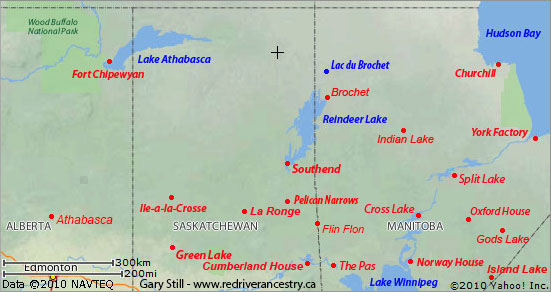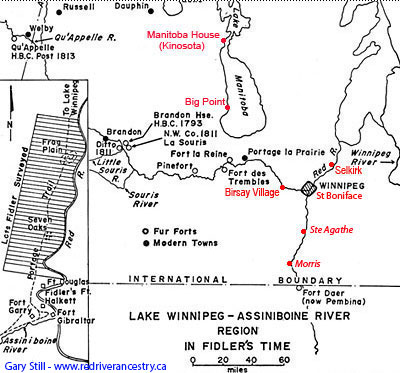ANDREW KIRKNESS (1770-1822+) (Last Updated: December 14, 2015)
Andrew KIRKNESS was born around 1770 in Birsay, Scotland (Orkney Islands). ** Some sources (unsubstantiated) indicate his parents as Margaret MANSON and Magnus KIRKNESS (1796-1865).
Andrew marries Margaret MOWAT
Around 1806-07 Andrew married Mary Margaret MOWAT, a Swampy Cree Indian. Around 1807 daughter Mary was born.
Ile a la Crosse with Peter FIDLER
During the period of 1810-11 Andrew KIRKNESS was working for the HBC under Peter FIDLER (1773-1835) as a Fisherman when he went to Ile a la Crosse. The HBC and the NWC shareholders (the Nor’Westers) were battling to dominate the fur trade in the Northwest (Rupert’s Land) at the time and the Nor’Westers resorted to extreme measures when FIDLER tried to set up a trading post not far from their own. FIDLER’s main antagonists in this episode were Samuel BLACK (1780-1841) and Peter Skene OGDEN (1790-1854) who were working under Nor’Wester John Duncan CAMPBELL (1773-1835). ** MORE ABOUT PETER FIDLER’s DARK DAYS at ILE A LA CROSSE In FIDLER’s Ile a la Crosse Journal he makes many references to Andrew KIRKNESS and his wife Margaret, in brief:
The Nor’Westers realized that lives of FIDLER’s men depended on their ability to feed themselves on fish and they set to work to cripple the HBC’s efforts at fishing. They would not let them set their nets in the better fishing depths, they tore up their nets and stole most of them. Finally on Aug 4, Andrew KIRKNESS, FIDLER’s best fisherman, deserted him in order to be with Margaret.
Excerpt from ‘One of a Family’, a book by Brenda Macdougall
There were no KIRKNESSes in Ile a la Crosse after this incident, so it seems that the family made no discernamble patryonic imprint on the English River District. However, the dynamics of family life and labour experienced by the KIRKNESS’ relationship set a long-lasting pattern for the Metis people of Sakitawak (Ile a la Crosse). At the start , a marital disbpute caused Mrs. KIRKNESS to leaver her husband and move to the other establishment. Motivated by love or by instinct for survival, Andrew KIRKNESS likewise abandoned the HBC for its rivals so he could be reunited with his wife. Life hinged on women’s ability to draw to them individuals who would become integral ro their family, as well as on women’s skills as articulated by FIDLER, who attempted several times to secure the return of Mrs. KIRKNESS before employing his own wife as the post fisher. Furthermore, residence patterns in Sakitawak were regionally matrilocal. In the case of the KIRKNESSes, Andrew followed his wife over to the NWC’s employ. There is no data on Mrs. KIRKNESS, so we do not know if she was Cree or Dene or if she was even from the region. Mrs. KIRKNESS had enough confidence in her knowledge of the area to leave her husband and move over to the NWC post alone. The HBC representatives rationalized the incident by blaming the NWC for what occurred, claiming that she was a captive rather than acknowledging that, as an Aboriginal woman, she had other choices about where and with whom she would live and work. This family-based self-interest was instrumental in shaping the form and content of Metis cultural life in Sikitawak over the next four generations.
It remains uncertain what became of Andrew KIRKNESS and his wife Margaret after 1811. Presumably Margaret remained behind with the Nor’Westers at Ile a la Crosse while Andrew went with Peter FIDLER to Fort Churchill.
The First Selkirk Settlers
On Sep 24, 1811 the first ship of Selkirk Settlers arrived at York Factory, bound for Red River but due to their late arrival, forced to remain there for the winter. ** MORE ABOUT LORD SELKIRK and his SETTLERS in DCBO In 1812 the aforementioned Peter FIDLER accompanied the first settlers to the Forks of the Red River (Kildonan). More settlers followed, and they were the cause of the Red River Metis Rebellion of 1815 led by Cuthbert GRANT (1796-1854).
It isn’t until 1820 that we rediscover Andrew and Margaret together again in St Andrews Parish (Red River) with the recorded birth of their son Andrew Jr.
Union of the North West Company with the Hudson’s Bay Company
In 1821 the union of the North West Company (NWC) and the Hudson’s Bay Company (HBC) occurred, ending the years of bitter rivalry for dominance of the fur trade in Western Canada. ) George SIMPSON (1786-1860) became the Governor of Rupert’s Land. ** MORE ABOUT GOVERNOR GEORGE SIMPSON
In 1833 daughter Mary married William BIRSTON in St Andrews, the son of an Indian woman & Alexander BIRSTON (1775-1829) from the Orkneys, a voyageur with the Hudson’s Bay Company (HBC). When Mary later claimed her Half-Breed Scrip, she stated her parents as Margaret MOWAT, an Indian, and Andrew KIRKNESS, a Scot. ** MORE ABOUT ALEXANDER BIRSTON
Around 1844 youngest son John married Elizabeth COOK, daughter of Catherine SINCLAIR and Joseph COOK (1788-1848). ** MORE ABOUT JOSEPH COOK
Around 1850 son Andrew Jr. married Sarah SETTEE, an Indian of uncertain origins. ** Some sources suggest that Sarah was a sister of the noted Indian clergyman, Reverend James SETTEE (1809-1902). ** MORE ABOUT REVEREND JAMES SETTEE
Andrew KIRKNESS JR. was the father of Joseph KIRKNESS (1856-1922) who married Margaret PHILLIPS in 1885.
In 1852 Mary Margaret (nee MOWAT) KIRKNESS died in St Andrews.
Comments and queries at this link: FORUM DISCUSSING the ANDREW KIRKNESS FAMILY
======================= Family Details =======================
Children: ** MORE ABOUT ANDREW KIRKNESS JR 3. 1822 JOHN KIRKNESS (m. Elizabeth "Betsy" (nee COOK) SUTHERLAND)
|


